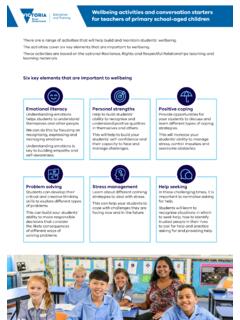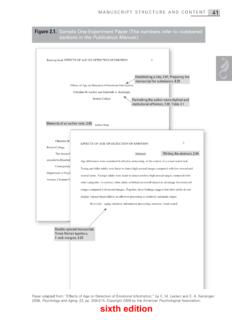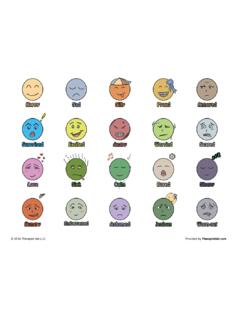Transcription of EMOTION What is emotion? What are the core aspects of …
1 EMOTION what is EMOTION ? EMOTION is difficult to define but always consists of feelings, behaviour, physiological change and cognitions and always occurs in a particular context which infl uences it. Its major function is to give information to the individual about their interaction with the world. what are the core aspects of EMOTION ? From an everyday perspective, the core aspects of EMOTION are to do with its expression (largely, although not solely, by the face) and its recognition. what are the emotions ? There are four or five basic emotions , basic in the sense of being clearly biologically grounded and important to the evolutionary survival of the individual. These are: anxiety/fear, sadness, anger, happiness/joy and disgust. Robert Plutchik created a wheel of emotions in 1980 which consisted of 8 basic emotions and 8 advanced emotions each composed of 2 basic ones.
2 Basic EMOTION Basic opposite Joy Sadness Trust Disgust Fear Anger Surprise Anticipation Sadness Joy Disgust Trust Anger Fear Anticipation Surprise Advanced EMOTION Composed Advanced opposite Optimism Anticipation + Joy Disappointment Love Joy + Trust Remorse Submission Trust + Fear Contempt Awe Fear + Surprise Aggressiveness Disappointment Surprise + Sadness Optimism Remorse Sadness + Disgust Love Contempt Disgust + Anger Submission Aggressiveness Anger + Anticipation Awe emotions by groups Here is a categorised, tree structured list of emotions as described in Parrot (2001) Primary EMOTION Secondary EMOTION Tertiary emotions Love Affection Adoration, affection, love, fondness, liking, attraction, caring, tenderness, compassion, sentimentality Lust Arousal, desire, lust, passion, infatuation Longing Longing Joy Cheerfulness Amusement, bliss, cheerfulness, gaiety, glee, jolliness, joviality, joy, delight, enjoyment, gladness, happiness, jubilation, elation, satisfaction, ecstasy, euphoria Zest Enthusiasm, zeal, zest, excitement, thrill, exhilaration Contentment Contentment, pleasure Pride Pride, triumph Optimism Eagerness, hope, optimism Enthrallment Enthrallment, rapture Relief Relief Surprise Surprise Amazement, surprise, astonishment Anger Irritation Aggravation, irritation, agitation, annoyance, grouchiness, grumpiness Exasperation Exasperation, frustration Rage Anger, rage, outrage, fury, wrath, hostility, ferocity, bitterness.
3 Hate, scorn, spite, vengefulness, dislike, resentment Disgust Disgust, revulsion, contempt, loathing Envy Envy, jealousy Torment Torment Sadness Suffering Agony, suffering, hurt, anguish Sadness Depression, despair, hopelessness, gloom, glumness, sadness, unhappiness, grief, sorrow, woe, misery, melancholy Disappointment Dismay, disappointment, displeasure Shame Guilt, shame, regret, remorse Neglect Alienation, isolation, neglect, loneliness, rejection, homesickness, defeat, dejection, insecurity, embarrassment, humiliation, insult Sympathy Pity, sympathy Fear Horror Alarm, shock, fear, fright, horror, terror, panic, hysteria, mortification Nervousness Anxiety, nervousness, tenseness, uneasiness, apprehension, worry, distress, dread what are the socially constructed and self-conscious emotions ? The socially constructed and self-conscious or self-referent emotions are: pride, shyness, embarrassment, guilt and shame.
4 Some of these emotions , as well as giving information to the individual, also function as mechanisms of social control. Is there any difference between men and women in EMOTION ? The stereotypes concerning the difference between men and women in EMOTION in Western society are partly borne out. Although women are not more emotional than men, they are encouraged to express EMOTION more than men and to be more responsible for its control both in themselves and others. Can emotions be wrong? emotions cannot be wrong. It may be that your expression of a particular EMOTION might be inappropriate in the context. It might not be regarded as seemly, for example, to give open vent to your anger at a board meeting or to continue grieving too openly for too long over the death of your cat. But the experience of such anger or grief is simply the experience and there is little you can do about it other than to give it due attention.
5 what is facial expression ? In human beings emotional behaviour has mainly been studied with respect to facial expression . The expressions for the various emotions seem to be universal although the rules for when and how much to express the emotions vary from culture to culture. what is the relation of EMOTION and physiological arousal? Physiological arousal is thought to be, but has not been proved to be, a necessary aspect of EMOTION . Both the autonomic and the central nervous systems are implicated in EMOTION although there is little to support the idea that each EMOTION has its own particular pattern of physiological response. what is the relation of EMOTION and cognition? There are intricate relationships between cognition and EMOTION , some psychologists believing that EMOTION cannot occur without cognition. The major form of cognition involved in EMOTION is the appraisal of the signifi cance of stimuli for the individual.
6 Whether or not cognition is necessary to EMOTION remains a moot point. Meta- EMOTION refers to the emotional reactions to one's own emotions (second-order emotions about primary emotions ). An example would be being angry (the primary EMOTION ) and being afraid of one's anger (the meta- EMOTION ). what comes first? You are walking down a dark alley late at night. You hear footsteps behind you and you begin to tremble, your heart beats faster, and your breathing deepens. At the same time as these physiological changes occur you also experience the EMOTION of fear. The thought? The physiological arousal? The behavior? Or does EMOTION exist in a vacuum, whether or not these other components are present? Behavior Physiological arousal EMOTION Thought COGNITION Cognition is a term referring to the mental processes involved in gaining knowledge and comprehension, including thinking, knowing, remembering, judging, and problem solving.
7 These are higher-level functions of the brain and encompass language, imagination, perception, and planning. Cognitions (Latin, cogito: to think) are the contents of cognitive processes) such as thinking and fantasy memory, attention, perception, etc. They include: Attitudes Beliefs Concepts Expectations Irrational beliefs It is clear that EMOTION and cognition are intimately intertwined and that EMOTION and motivation are also connected. It is diffi cult to understand EMOTION without considering cognition. Consider the elements that go to make up the reaction. It is your beliefs or knowledge about the nature of root canal operations that lead to the anxiety. You have considered what is to come and judged how it is likely to affect you. The result is anxiety. The emotional reaction has followed on the heels of cognitions in the form of beliefs and knowledge.
8 If you had already experienced a root canal procedure and found that it was easy and painless, then your beliefs would be different and you would not be anxious. The main way in which cognitions and emotions are linked is through appraisals. When anything happens, we evaluate what it means for us, its significance to us this is an emotional appraisal, or an appraisal that leads to an emotional reaction. These appraisals are believed to help us in making fine distinctions about our emotional experiences or in determining the extent or the intensity of the EMOTION . For example, seeing a $100 note on the pavement would produce a very different emotional reaction from seeing the same note in a pool of vomit. There are (at least) two sides to the matter appraisals always precede EMOTION , and cognition and EMOTION are independent (although often related). If you are standing waiting to pay in a cafeteria with a laden tray and someone crashes into you from behind, sending everything flying, your reaction is likely to be instantaneous and to ocur without apparent thought.
9 MOTIVATION Motivation is a word used to refer to the reason or reasons for engaging in a particular behavior, especially human behavior as studied in psychology and neuropsychology. These reasons may include basic needs such as food or a desired object, goal, state of being, or ideal. Physiological motivation Basic physiological needs for food drink sleep and activity etc have to be met on a regular basis: Exploratory behavior Hunger as motivation Sex drive Thirst as motivation Cognitive motivation Achievement, ambitions Social motivation Affiliation motivation Types of motivation Intrinsic motivation is when people engage in an activity, without obvious external incentives, such as a hobby. Extrinsic motivation is when people engage in an activity for external rewards and monetary incentives Instinct X Motivation Instinct theory= Freud asserted that human behavior could be explained by two major instincts: the instinct to survive (such as a drive for sexual reproduction) and the instinct to avoid death, which causes aggression.
10 Theory of drives= a driving force originates from a natural need, like thirst. Lack of food causes chemical changes in the blood, which causes the need for food, which stimulates the organism to look for food. Motivation Incentives can be better understood as an interaction between external inputs and needs of an organism. An example is a beautiful display with cakes and pastry, which can make you feel hungry even after dinner. The drive does not originate from a an internal need, but is triggered by an external input. The organism will seek for positive incentives and will avoid negative incentives. For a thirsty animal, water will be a positive incentive to drink. However, it will avoid painful situations. Factors affecting motivated performance A number of factors can modify the effects of motivation: Aptitude Commitment Delay of gratification Enthusiasm Fear of success Intention Motivation training Persistence Planned behavior Preference Procrastination Temptation Abraham Maslow (1970) Hierarchy of Needs Maslow believed that humans have specific needs that must be met and that if lower level needs go unmet, we can not possible strive for higher level needs.
![ders3.ppt [Uyumluluk Modu] - ogelk.net](/cache/preview/2/d/8/f/8/5/6/4/thumb-2d8f8564415028747f3771ca166fbffe.jpg)





